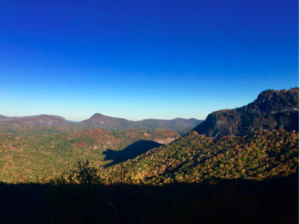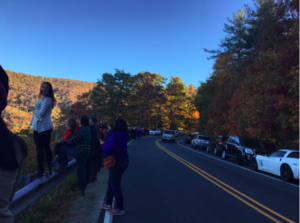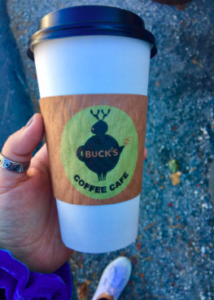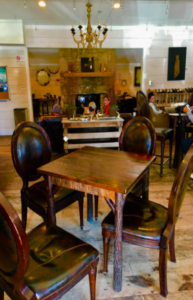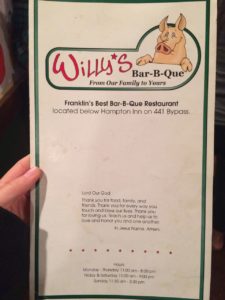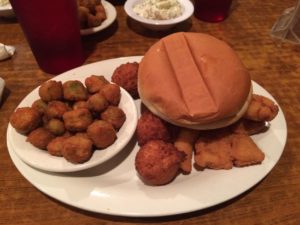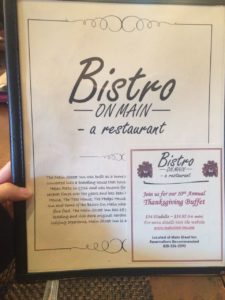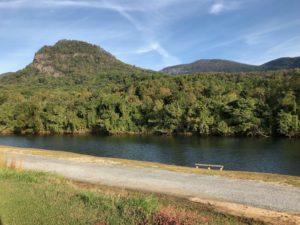 Along the winding road of Highway 64 lies Lake Lure. This small town is known for its parks, historic landmarks, and, as denoted by its name, winding lake. Lake Lure is not vast in size, with a population just shy of 2,000 people, but it’s landmarks cannot be missed during a journey down Highway 64. When traveling from the west, you will first stumble upon the grand entrance to Chimney Rock State Park. A quick turn in will lead you through a tree lined climb up to the state park entrance. The road, which is surprisingly wide enough to fit two-way traffic, is a difficult drive. However, the clearing at the top that houses the Chimney Rock entrance is a welcome surprise. The entrance is home to a guardhouse that must be passed through before being admitted into the park. While waiting in line to speak with the park guard, the view is incredible. You can see Chimney Rock and the hike up along with a beautiful blue sky and autumn leaves if you, like us, visit on a clear October morning. Be advised, however, that admission into the park is not without cost. At a rate of $13 per adult and $6 per child, tickets to this unique experience can be purchased both online and at the park entrance gate. This seemingly steep admission cost caught us by surprise. As a result, we turned around and braved the treacherous drive once over to see what else Lake Lure had to offer.
Along the winding road of Highway 64 lies Lake Lure. This small town is known for its parks, historic landmarks, and, as denoted by its name, winding lake. Lake Lure is not vast in size, with a population just shy of 2,000 people, but it’s landmarks cannot be missed during a journey down Highway 64. When traveling from the west, you will first stumble upon the grand entrance to Chimney Rock State Park. A quick turn in will lead you through a tree lined climb up to the state park entrance. The road, which is surprisingly wide enough to fit two-way traffic, is a difficult drive. However, the clearing at the top that houses the Chimney Rock entrance is a welcome surprise. The entrance is home to a guardhouse that must be passed through before being admitted into the park. While waiting in line to speak with the park guard, the view is incredible. You can see Chimney Rock and the hike up along with a beautiful blue sky and autumn leaves if you, like us, visit on a clear October morning. Be advised, however, that admission into the park is not without cost. At a rate of $13 per adult and $6 per child, tickets to this unique experience can be purchased both online and at the park entrance gate. This seemingly steep admission cost caught us by surprise. As a result, we turned around and braved the treacherous drive once over to see what else Lake Lure had to offer.
Suffering from car sickness from the windy drive along Highway 64, the Lake Lure Beach and Water Park was a welcome sight. This park was not only beautiful, but it was free. A small information building sat just beyond the parking lot as the first stop in the park before venturing beyond to find basketball courts and grassy fields, each leading to Lake Lure. Sitting down a hill, the lake, which is the namesake for the town, can easily be confused for a river. Its narrow and winding path is home to docks and boats, and its shoreline is fairly undeveloped beyond a smattering of houses. The public access to the lake’s beach is free of charge and full of outdoor resources. We were not alone on our early Saturday morning visit: a pick-up game was taking place with children on the basketball court, locals were walking along the lake, and families were enjoying a picnic breakfast on the park picnic tables. That being said, just driving through, there was not much to do at the lake beyond enjoy the much need fresh air to settle sick stomachs. After an enjoyable walk, we once again piled into the car in search of our next destination.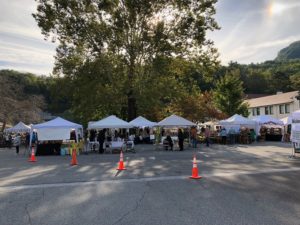
Lucky for us, the next destination was right across the street. Upon pulling out of the beach parking lot, we were shocked to see what appeared to be a village of tents, especially so early on Saturday morning when the rest of the town appeared to still be sleeping and store fronts were closed. We were eager to park and see what all the excitement was about. To our thrill, we had lined our trip up perfectly with the bi yearly Lake Lure Arts and Crafts Festival. The festival happens each year for two days during a weekend in October and for three days during Memorial Day weekend. For more information on the fair, read For Lovers of Crafts and Good Times by other student visitors that also experienced the Festival. As fans of soaps and candles, we were beyond impressed by the offerings of this festival. With rows and rows of vendors as well as a few food trucks, the over 60 artisans presented their homemade creations under white tents. Their work ranged from fairly expensive pottery to more unique homemade dolls and children’s toys.
We were first attracted to the candles at the Fresh Scent Soy Candles booth. The Spains, an outgoing and friendly husband and wife duo that run the business, educated us on their products, associated benefits, and the creation process. As we smelled all of their unique candle flavors, they were thrilled to share a detailed account of what differentiates their product from candles sourced from stores. Each soy candle is sold in a glass, mason-like jar and priced at $10. We were so impressed by the candles and their maker that we collectively purchased two. After walking around and fully immersing ourselves in all the festival had to offer, our final stop was Bully Bites. Attracted to their tent by their bulldog mascot, this homemade, all natural dog treat vendor was a great end to our visit. After chatting with the baker, we learned that although these dog treats rival their store-bought competitors, they are very different. They are fresh, meaning they either need to be refrigerated or frozen, and contain ingredients that contend with human food. Creating these treats is an effort to make dogs healthier; only wholesome ingredients are used and preservatives are omitted for a high-quality product. Excited by the healthy differences in these dog treats, we bought two unique $10 bags to bring back to our pups. As we paid with our credit cards, we were surprised by the connectivity of such a remote event. Although it took a second to load the Square app due to minimal internet service, it was fairly common to accept credit cards at the festival.
After a successful stop and multiple purchases, we headed back towards the car. Fulfilled by our time in Lake Lure, we were excited to get back on the road.





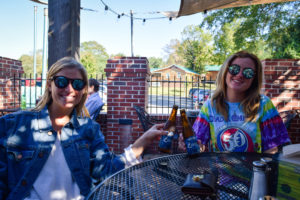 al oasis that is Saxapahaw, North Carolina. For tow n locals, as well as residents of Chapel Hill and Burlington in search of a liberal community, Saxapahaw provides a transport away from daily life. For Amidst a historical brick complex consisting of a local brewery, butchery, The Eddy Restaurant and Pub, and the Haw River Ballroom, there lies today’s destination: a yellow and red gas station and one-room general store.
al oasis that is Saxapahaw, North Carolina. For tow n locals, as well as residents of Chapel Hill and Burlington in search of a liberal community, Saxapahaw provides a transport away from daily life. For Amidst a historical brick complex consisting of a local brewery, butchery, The Eddy Restaurant and Pub, and the Haw River Ballroom, there lies today’s destination: a yellow and red gas station and one-room general store. lectic expanse of merchandise. The three aisles in the store include a nice selection of local and nonlocal wines, beers, and kombucha; select grocery items such as pet food; and a plethora of artisan goods–ranging from organic name-brand snacks, to homemade chocolates, to all-natural soy candles and homeopathic lotions, oils, and hair products. The display of local products is frequently rotated, featuring different self-made t-shirts, hand-knit mittens, or personalized keychains. Despite artisan prices, it is easy to find small treasures that are special and worth the purchase.
lectic expanse of merchandise. The three aisles in the store include a nice selection of local and nonlocal wines, beers, and kombucha; select grocery items such as pet food; and a plethora of artisan goods–ranging from organic name-brand snacks, to homemade chocolates, to all-natural soy candles and homeopathic lotions, oils, and hair products. The display of local products is frequently rotated, featuring different self-made t-shirts, hand-knit mittens, or personalized keychains. Despite artisan prices, it is easy to find small treasures that are special and worth the purchase. ers place their orders, built into view as part of the minimalist and transparent cuisine mission. If eaters come to dine on a sunny North Carolina day, they may eat outside on the terrace beneath vine-covered pergolas, sharing a bottle of wine or old-fashioned sodas while they wait for their server to bring out their meals.
ers place their orders, built into view as part of the minimalist and transparent cuisine mission. If eaters come to dine on a sunny North Carolina day, they may eat outside on the terrace beneath vine-covered pergolas, sharing a bottle of wine or old-fashioned sodas while they wait for their server to bring out their meals.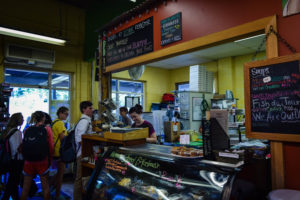 phere–from the people, to the artisan goods–allows customers to feel like they are on a quick vacation from the typical Piedmont North Carolina lifestyle. The General Store warrants a strong recommendation to visit for those who want to diversify their impression of North Carolina culture and who wouldn’t mind a short, worthwhile detour off Highway 64.
phere–from the people, to the artisan goods–allows customers to feel like they are on a quick vacation from the typical Piedmont North Carolina lifestyle. The General Store warrants a strong recommendation to visit for those who want to diversify their impression of North Carolina culture and who wouldn’t mind a short, worthwhile detour off Highway 64. s of apples, each labeled in the same cursive handwriting. Above them lies an entire wall of cowboy hats in every color you imaginable. To the left appears about every type of butter and jam known to man, each in the same gold-lidded mason jar. The place gave me that same feeling I get in my grandmother’s attic, cluttered yet somehow everything seems to hold some sort of memory or value.
s of apples, each labeled in the same cursive handwriting. Above them lies an entire wall of cowboy hats in every color you imaginable. To the left appears about every type of butter and jam known to man, each in the same gold-lidded mason jar. The place gave me that same feeling I get in my grandmother’s attic, cluttered yet somehow everything seems to hold some sort of memory or value. 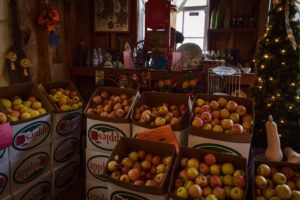 Chicago local.
Chicago local. 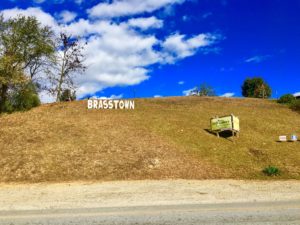 Past a gas station screenshot from the ‘60s was the town of Brasstown. Composed of a mail center, library, and gas station, the surrounding hill was a collection of homes bordered with signs encouraging the election of Trump/Pence.
Past a gas station screenshot from the ‘60s was the town of Brasstown. Composed of a mail center, library, and gas station, the surrounding hill was a collection of homes bordered with signs encouraging the election of Trump/Pence.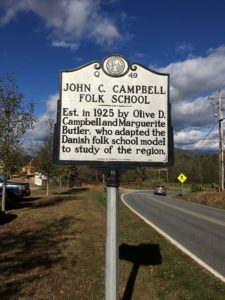 Embedded between conversations of life and relationships, he spoke about the history of the Folk School in milestones. Between the dedicated commitment to working the land and building a new system of education was a history of community. His work focuses on documenting the stories of the people who populate the folk school. He mentioned that his interviews from the past few years have been especially interesting since he is recording and telling the story of the grandchildren he originally spoke to in the formation of the folk school in the 1920s. The motto of the folk school, as seen by the countless signs and embossing is “I sing behind the plough.”
Embedded between conversations of life and relationships, he spoke about the history of the Folk School in milestones. Between the dedicated commitment to working the land and building a new system of education was a history of community. His work focuses on documenting the stories of the people who populate the folk school. He mentioned that his interviews from the past few years have been especially interesting since he is recording and telling the story of the grandchildren he originally spoke to in the formation of the folk school in the 1920s. The motto of the folk school, as seen by the countless signs and embossing is “I sing behind the plough.”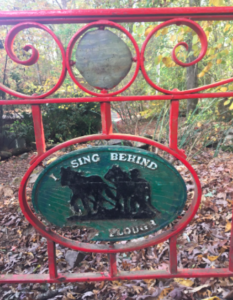 The crafts of the folk school were varying in discipline and medium. Kaleidoscopes, mosaics, and pottery sprinkled the wooden show room with color. Their craft store was composed of aisles of colorful art crafted throughout North Carolina. Each stand of work had the name of the artist and the home of the craft on a small paper in front of the pieces.
The crafts of the folk school were varying in discipline and medium. Kaleidoscopes, mosaics, and pottery sprinkled the wooden show room with color. Their craft store was composed of aisles of colorful art crafted throughout North Carolina. Each stand of work had the name of the artist and the home of the craft on a small paper in front of the pieces.